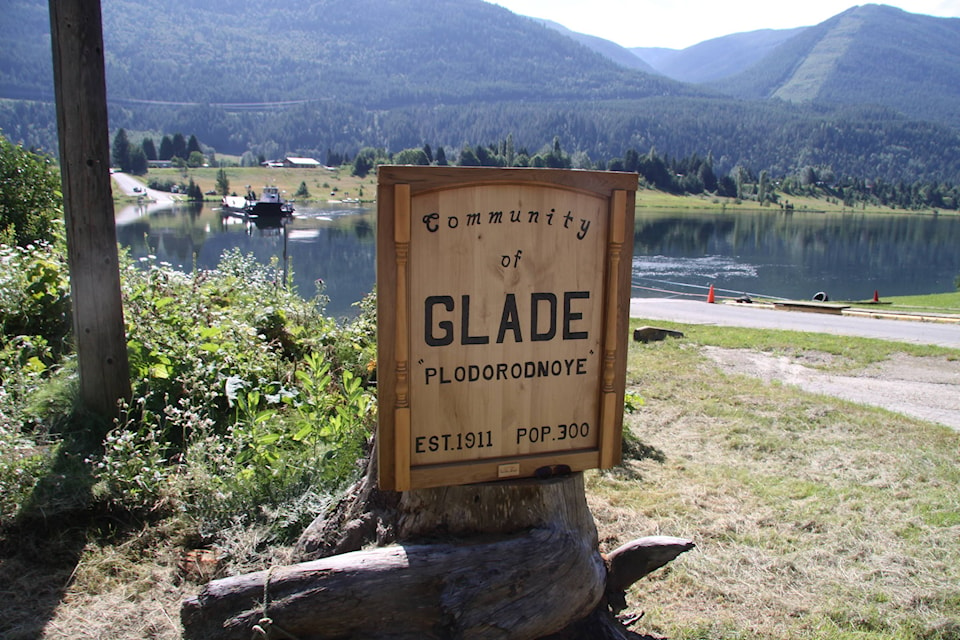Three hundred tenth in a series on West Kootenay/Boundary place names
Community Doukhobors began migrating from Saskatchewan to BC in 1908. Only a handful of names they gave their settlements are commonly used today, while a few others are in limited use, but they form one of the most unique subsets of place names in West Kootenay/Boundary.
• Doukhobor leader Peter (Lordly) Verigin reportedly wanted to name land purchased at the confluence of the Kootenay and Columbia rivers Kavkaz (Кавказ), after their homeland in the Caucasus mountains. However, local settler Hiram Landis convinced him it would be too hard to pronounce.
Instead, it was named Brilliant Chistoy Vody (Бриллиант Чистой Воду), which according to Jon Kalmakoff of the Doukhobor Genealogy Website means “diamond of the first water,” although it’s often mistranslated as “Brilliant shining waters.”
The expression, used to describe diamond quality, referred here to the sparkling water of the rivers.
Kalmakoff adds: “But it may very well also be a reference to the spiritual purity and clarity of Peter Verigin’s followers who he resettled to this new place.”
The name was soon shortened to Brilliant (Бриллиант), which sounds similar in Russian and English. The Brilliant post office closed in 1970, but the name is perpetuated in two streets, two bridges, a cemetery, and the Brilliant Cultural Centre.
• Verigin also chose the name Dolina Uteshenaya (Долина Утешениая) for land purchased south of the Kootenay River and east of the Columbia, meaning “valley of consolation.” It was shortened to Utesheniye (Утешение). While there have been many English transliterations, it was officially adopted as Ootishenia in 1951 and changed to Ootischenia in 1959.
While Ootischenia school closed in the 1980s, the name is perpetuated in a street, creek, cemetery, fire department, and landfill.
• An area purchased near Crescent Valley in 1911-12 was named Dolina Krestova (Долина Крестова), meaning “valley of the cross.” It was later shortened to Krestovoye (Крестовое) and then Krestova (Крестова). It was also frequently transliterated as Crestova — the English spelling did not settle firmly on Krestova until the late 1960s.
The name is perpetuated in several streets.
• An area at West Grand Forks purchased in 1909 was named Dolina Fruktova (Долина Фруктова), meaning “Valley of fruit.” Later it was shortened to Fruktovoye (Фруктовое) and then Fruktova (Фруктовa). It was also transliterated as Fructova and Fruitova, the names given to a school that operated from 1929-49. The school is now the Boundary Museum, but the building is still commonly referred to as Fructova.
After 1928, the area became better known as Sion (Сион) after nearby Spencer Hill, which Doukhobors called Sionskaya Gora (Сионская Гора), meaning Mount Sion or Sion Hill, in reference to the Biblical Zion. The name is perpetuated by a street and the Sion Improvement District.
• The settlement at Glade, established in 1911, was known as Dolina Plodorodnaya (Долина Плодородная), meaning “fertile valley” and later shortened to Plodorodnoye (Плодородное). Although the name fell out of use, it was included on new welcome signs erected in time for Glade’s centennial.
• A settlement established at the confluence of the Columbia River and Champion Creek in 1912 and known as Blagodatnoye (Благодатное), meaning “blessed” or “abundant.” The last family left in the early 1970s. The name is perpetuated on a sign on the cemetery, which is the only thing remaining there aside from a few foundations and some old orchards.
• A settlement at Shoreacres, established in 1912, was named Prekrasnoye (Прекрасное), meaning “beautiful.”
• Doukhobors who lived at Koch Siding in the Slocan Valley Russianized the community’s name as Kov (Ков). In 1928, Peter (Chiastiakov) Verigin renamed the settlement Petrovka after himself, but it didn’t stick.
• Doukhobor settlers at Perry Siding called the area Persikovoye (Персиковое), meaning “land of peaches.”
• The Pass Creek valley was named Dolina Lugovaya (Долина Луговая), meaning “meadow valley,” and later shortened to Lugovoye (Луговoe). The area was also called Mordovskoye (Мордовское) because many residents had Mordivian ancestry.
• Ubezhishche (Убежище) was named by community Doukhobors who bought land along July Creek near Grand Forks in 1909. It means “refuge” or “hideaway.”
• Chistyakovoye (Чистяковое), or Chistyakovka, was named by independent Doukhobors who settled in the Carson area of Grand Forks between 1937 and 1943 after leader Peter (Chistiakov) Verigin.
• Norsan (Норсан) was a Russianization of Nursery, a farming area east of Grand Forks where community Doukhobors settled between 1937 and 1943.
There were and are many other geographic features and street names associated with the Doukhobors. Kalmakoff’s Doukhobor Gazetteer at doukhobor.org/gazetteer-intro.html enumerates all of these sites in BC as well as Saskatchewan, the US, Russia, and around the world.
